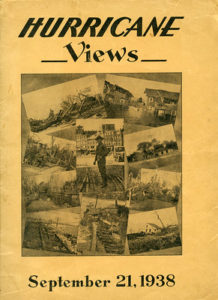During the month of September in 1938, Norwich was enjoying the type of late summer weather it had grown accustomed to in years past. However, the middle of the month ushered in several consecutive days of heavy rain that saturated the ground in Eastern CT and caused the region’s rivers to rise to near flood stage.
The Stafford dam collapsed in the middle of the night on Tuesday September 20th sending water flowing into the Willimantic River. The Quinebaug, Shetucket and Yantic rivers also reached flood stage sending excess water into the Thames River. Water poured into the Franklin Square area quickly surpassing the flood levels reached just two years earlier in 1936. These events were all a prelude to the arrival of the hurricane itself.
At around 3 p.m. on Wednesday September 21st, the hurricane with its expansive scope stretching from New York City to Nantucket, reached southeastern Connecticut. The powerful winds ripped off the north tower of the United Congregational Church and the top story of the Broadway School. Water continued to rise at the rate of seven feet per hour caused by the tidal surge created by the hurricane. Eventually the water rose to the height of eight feet at the corner of Franklin and Bath Streets. Later that day the Eighth Street Bridge in Greenville was swept away and parts of the drawbridge were later discovered near New London, thirteen miles away. Norwich overall suffered extensive damage to many buildings both residential and commercial. Remarkably, no lives were lost during this powerful natural disaster.
To see photos of this historic day in southeastern Connecticut, go to the Otis Library’s Flickr page.

